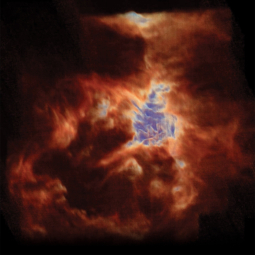New data from NASA’s Stratospheric Observatory for Infrared Astronomy, SOFIA, reveal a three-dimensional (3-D) view of the Orion Nebula – Earth’s closest star-formation nursery – and a powerful stellar wind. Researchers can rotate, zoom in, and even dive through this data cube to better understand how stars are forming.
The observatory’s instrument called the German Receiver for Astronomy at Terahertz Frequencies, known as GREAT, measures the chemical fingerprints of light, called spectra. A recent upgrade to this instrument allowed researchers to record more than 2 million carbon spectra in only 40 hours! They combined these spectra, creating not just an ordinary image of the nebula, but a data cube with a velocity measurement at every position.
This 3-D view reveals a rich structure of the whole nebula, including not only a bubble created by the stellar wind, but also filaments, colliding flows, and a completely distinct view of the molecular gas distribution. The observations provide new insights into the kinematics and dynamics of the shell surrounding the bubble of material blown out by the strong stellar wind.
“As we rotated the data cube, we got our first glimpse of the structure that we’ve nicknamed Orion’s Dragon,” noted Rhys Taylor, a scientist at the Astronomical Institute of the Czech Academy of Sciences and a consultant on the project. “A few people have said it looks like a sea horse or a pterodactyl, but it looks like a dragon to me.”
The interaction of massive stars, like the one creating this wind, with their surrounding environments regulates the evolution of star formation. Energy from these massive stars stirs up the medium, heats the gas, and disrupts the birth sites of new stars. Until now, it was generally thought that supernova explosions were the dominating factor controlling the environment of star-forming clouds, but these results from SOFIA show that the stellar wind interactions dominate feedback at a much earlier phase in the cloud’s star-producing lifetime.
View or download video of Orion's Dragon:
MultiVolumeRotate_MipMap.mpg
(13 MB)
Orion_anaglyph_test.mpg
(9.3 MB)
OrionSpin0001-0250.mpg
(13 MB)
SOFIA is a Boeing 747SP jetliner modified to carry a 106-inch diameter telescope. It is a joint project of NASA and the German Aerospace Center, DLR. NASA’s Ames Research Center in California’s Silicon Valley manages the SOFIA program, science and mission operations in cooperation with the Universities Space Research Association headquartered in Columbia, Maryland, and the German SOFIA Institute (DSI) at the University of Stuttgart. The aircraft is maintained and operated from NASA’s Armstrong Flight Research Center Hangar 703, in Palmdale, California.
